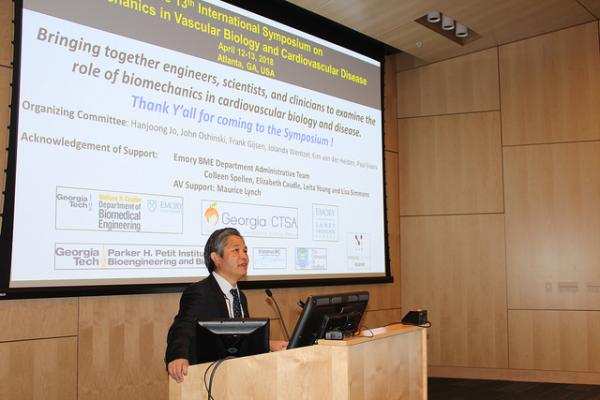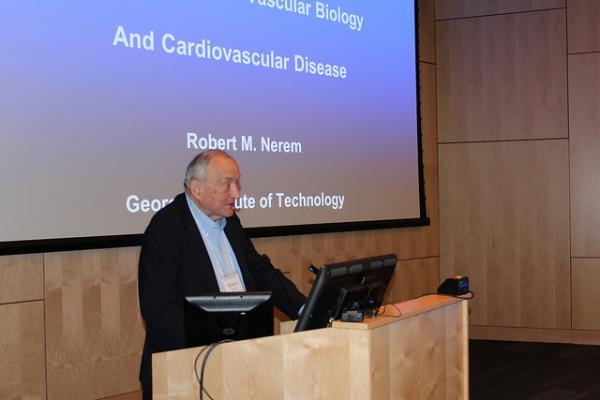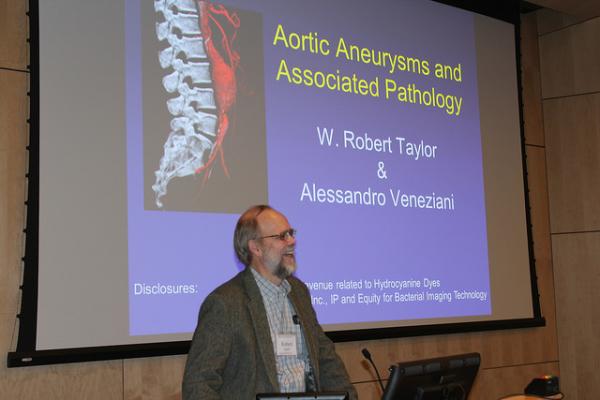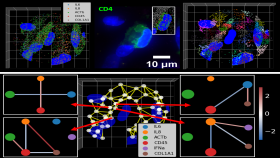The 13th annual International Symposium on Biomechanics in Vascular Biology and Cardiovascular Disease was held April 12-13 at Emory University, where the latest discoveries and most current research was shared in the Health Science Building, home to the Wallace H. Coulter Department of Biomedical Engineering on the Emory campus.
The symposium attracted more than 120 experts from around the world at a two-day event which alternates each year between Europe and the United States.
“This year’s symposium discusses the role of biomechanics in vascular biology and cardiovascular disease and includes in-depth research regarding arthrosclerosis, aortic valve disease and aneurisms,” said Hanjoong Jo, professor in the Coulter Department at Emory and Georgia Tech, John and Jan Portman Professor at Emory, and one of this year’s symposium organizers.
“Cardiovascular disease is associated with one of every four deaths in the United States and is the leading cause of death in both men and women,” he added. “We feel this is a very important area of study and several early collaborations between Emory and Georgia Tech pioneered critical connections between the biomechanics and cardiovascular diseases. Teams of clinicians, scientists, and engineers at both Emory and Georgia Tech have been leaders in this field for many years.”
Keynote speakers for the event included Robert Taylor from Emory, Roger Kamm from the Massachusetts Institute of Technology, and Elisa Konofagou from Columbia University.
More than 30 years ago, the three initial leaders in this field at Georgia Tech were Don Giddens, Robert Nerem, and Ajit Yoganathan, who were engineers working with cardiologist Wayne Alexander and other physicians at the Emory School of Medicine, studying the role of biomechanics in cardiovascular disease. These research partnerships ignited this new field of study and the tradition continued with Hanjoong Jo; John Oshinski, Larry McIntire, former chair of the Coulter Department; Robert Taylor, directory of cardiology at Emory’s School of Medicine; and Habib Samady, cardiologist at Emory.
Yoganathan’s lab has pioneered the use of biomedical devices related to the development of aortic valves. The Jo lab is a leader in identifying novel therapies based on genes that are regulated by flow.
The hiring of more research scientists such as Rudy Gleason, Alessandro Veneziani, and Amir Rezvan between Georgia Tech and Emory followed, as the universities added physicians and engineers specifically focused on the field of biomechanics in cardiovascular disease. And a next generation of biomedical engineers is following in their footsteps, taking the research further.
One recent example resulting from this focused effort is BME doctoral student Rob Mannino from the Wilbur Lam lab at Emory. Lam, assistant professor in the Coulter Department, is dedicated to applying and developing nanotechnologies to study, diagnose, and treat blood disorders, cancer, and childhood diseases in his lab.
This past year, Mannino’s dissertation project with Dr. Lam has won two major competitions raising $200,000 for his project to support a painless, smart phone app that tests for anemia—eliminating the need for expensive and painful blood draws.
Today, as world leaders in this area, there are dozens of researchers exploring the biomechanics of vascular disease across Georgia Tech and Emory.
Media Contact
Walter Rich
Keywords
Latest BME News
Commercialization program in Coulter BME announces project teams who will receive support to get their research to market.
Courses in the Wallace H. Coulter Department of Biomedical Engineering are being reformatted to incorporate AI and machine learning so students are prepared for a data-driven biotech sector.
Influenced by her mother's journey in engineering, Sriya Surapaneni hopes to inspire other young women in the field.
Coulter BME Professor Earns Tenure, Eyes Future of Innovation in Health and Medicine
The grant will fund the development of cutting-edge technology that could detect colorectal cancer through a simple breath test
The surgical support device landed Coulter BME its 4th consecutive win for the College of Engineering competition.
New research from Georgia Tech helps doctors predict how therapies will interact with a child's immune system, potentially improving outcomes and reducing risks.










